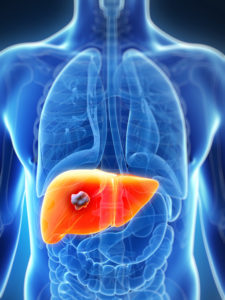Home » Liver Cancer
Liver Cancer
About Liver Cancer
Liver cancer, also called “Hepatocellular carcinoma”, HCC, has several types based on the type of cells which turn cancerous.
Liver cancer is aggressive, since most of the patients are diagnosed in an advanced stage, where the disease is considered incurable, for the most part.
The patient’s life expectancy is poor and currently stands on 3-5 year; this is with the support of the standard treatments.
To improve patients’ chances, the American Society for Clinical Oncology, ASCO, that includes various specialists in its panel, such as oncologists, radiologists, gastrologists among others, guides oncologists to inform liver cancer patients in all topics related to clinical trials in every stage of their disease.
The National Cancer Institute, NCI, of the United States, stresses that for liver cancer patients, the preferred treatment option is to join one of the many clinical trials around the world and thus increase the chances of success over the standard protocols.
Types of Liver Cancer
Two sub-types of liver cancer can be distinguished, based on the origin of the tumor:
- Liver cancer which is a type of cancer originates from the liver cells itself
- Metastases in the liver also called “Secondary liver cancer”. This happens when a tumor originated from other part of the body spreads to. Breast cancer, colorectal cancer and others can spread to the liver. In these cases, the tumors in the liver are not “liver cancer” but rather breast or colorectal or other tumors (metastases, stage 4) and the patient is treated as a breast or colorectal or other cancer patient and not as a liver cancer patient.
Liver cancer Hepatocellular Carcinoma, HCC
Also called “Hepatoma”, is the most common type of liver cancer, accounting for approximately 75 percent of all liver cancers. HCC starts in the main type of liver cells, called “Hepatocellular Cells”.
Main causes of HCC:
- Hepatitis B or C
- Alcoholism
Fibrolamellar HCC
A rare type of HCC that is typically more responsive to treatment than other types of liver cancer.
Cholangiocarcinoma (bile duct cancer)
Occurs in the small, tube-like bile ducts within the liver that carry bile to the gallbladder. Cholangiocarcinoma prevalence is 10-20% of all liver cancers.
To read more about Cholangiocarcinoma>>
Angiosarcoma, also called “Hemangiocarcinoma”
Accounts for about 1 percent of all liver cancers. Angiosarcomas begin in the blood vessels of the liver and rapidly grow. They are mostly diagnosed at an advanced stage of the desease.
Metastases in the Liver also called “Secondary Liver Cancer”
Develop when primary cancer from another part of the body spreads to the liver, e.g. More than half of patients diagnosed with colorectal cancer develop secondary liver cancer and breast cancer tend to metastasize in the liver as well.
Liver Cancer Symptoms
These may include:
- Losing weight without trying
- Loss of appetite
- Upper abdominal pain
- Nausea and vomiting
- General weakness and fatigue
- Abdominal swelling
- Yellow discoloration of the skin and the whites of your eyes (jaundice)
- White, chalky stools
Treatment Goals
The goal of treating local cancer, not metastatic, is to remove and eradicate the tumor completely.
In metastatic stage 4 disease, the primary objective of the treatment is to slow down and control disease progression and help reduce symptoms as well prolong life and improve patient’s quality of life.
Standard Treatments
A number of therapies are possible, and many patients shall receive more than one type of therapy. Treatment options for liver cancer depend on several factors, like a patient’s overall health, how much liver damage has been caused by cancer, hepatitis or cirrhosis and whether the cancer has spread.
Surgery
The purpose is to remove the tumor and the area adjacent to it. The tumor will be studied under the microscope to identify and diagnose the type of cancer.
Two main types of treatment may be offered to patients before and after surgery
- Treatment prior to surgery is known as ‘Neoadjuvant’
Usually this stage of treatment will involve chemotherapy and/or radiotherapy intended to reduce the tumor’s size and improve the success of surgery.
- Post-surgery treatment, also known as ‘Adjuvant’
This treatment seeks to cure and prevent the appearance of metastases or recurrence of the tumor.
Ablation
Ablation is treatment that aims to destroy tumors in the liver without taking them out. These techniques can be used in patients with a few small tumors and when surgery is not a good option. They are less likely to cure the cancer than surgery, but they can still be very helpful.
Ablation is best used for tumors no larger than 3 cm across. Because ablation often destroys some of the normal tissue around the tumor, it warrants special consideration in certain cases depending on the location of the tumor.
Often, ablation can be done by inserting a needle or probe into the tumor through the skin. The needle is guided into place with ultrasound or CT scan.
Radiation
Radiation therapy for cancer in the liver uses targeted energy, similar to an X-ray, to destroy cancer cells, shrink tumors and/or relieve symptoms while reducing exposure and damage to normal, healthy tissue.
Chemotherapy
Before surgery to destroy cancer cells and shrink tumors
After surgery to target cancer cells that may have been left behind
As a systemic treatment to treat locally advanced or metastatic liver cancer
The most common chemotherapy drugs for treating liver cancer include:
- Gemcitabine (Gemzar)
- Eloxatin®, (Oxaliplatin)
- Cisplatin
- Doxorubicin (pegylated liposomal doxorubicin, Doxil®)
- Adrucil®, (Fluorouracil, 5-FU)
- Xeloda®, (Capecitabine)
Sometimes, combinations of 2 or 3 of these drugs are used.
Targeted Therapy
Those drugs specifically bind to unique biomarkers like receptors and proteins that feature the individual cancer cells. Once attached to targeted cancer cells, the drugs work by either killing the cells or helping other therapies, such as chemotherapy, identify and target cancer cells.
Under this category, you may find:
- Sorafenib (Nexavar®)
- Lenvatinib (Lenvima®)
- Regorafenib (Stivarga®)
- Cabozantinib (Cabometyx®)
- Ramucirumab (Cyramza®)
Immunotherapy
Immunotherapy drugs assist the immune system in attacking the tumor. This type of treatment is very different from chemotherapy, for example, which directly attacks the cancerous cells but unfortunately also damages healthy tissues.
The immune system has “immune barriers” which serve to regulate the immune system and prevent it from attacking the body. In cancer these functions are readily activated and as a result, the immune system ceases to attack cancerous cells, enabling the tumor to grow and proliferate in the body.
Barriers known as PD-L1, PD-1 and CTLA-4 are found on T-cells and cancer cells.
Immunotherapy is a revolutionary strategy, and one of the most widely studied worldwide for its application to numerous types of cancer and various stages of the disease’s development. Treatment is generally provided in the form of an intravenous infusion.
Examples of immunotherapy drugs for liver cancer
- Keytruda® (Pembrolizumab)
- Opdivo® (Nivolumab)
 Advanced Cancer Drugs, Breakthrough Treatments and Clinical Trials from Around the World for Liver Cancer Patients
Advanced Cancer Drugs, Breakthrough Treatments and Clinical Trials from Around the World for Liver Cancer Patients
Facts
- The existing therapies used on stage 4 metastatic liver cancer are not curative, and this is a source to the need for innovative and effective treatment strategies in order to fight the disease.
- The National Cancer Institute, NCI, highlights the fact that for a certain group of liver cancer patients, the best treatment option is to join one of the many clinical trials existing worldwide aiming to increase their chances of therapeutic success.
- Currently, every patient will be offered the standard protocols described above. Sometimes the oncologist may suggest integrating these therapies with trials carried out in the institute.
The Opportunity
- Advances in cancer therapies may be found in clinical trials prescribing cutting edge, innovative drugs, some of which have already been recognized by the US Food & Drug Administration, the FDA, as “breakthrough drugs” and require further information to be approved.
- An entire world of clinical trials, Compassionate drugs and advanced new cancer treatments are available worldwide.
- It is important to know and have access to cutting edge cancer treatments that best match the unique medical condition of the patient and increase chances in winning the fight against compared to the standard care offered.
Note to remember!
Not every patient is eligible to enter a specific clinical trial. The eligibility conditions must be fully met and each case is reviewed separately to ensure that the clinical trial matches to the specific cancer patient and vice versa.
References:
ttps://www.fda.gov
https://www.ema.europa.eu
https://www.health.gov.il
https://www.cancer.org
https://www.cancerresearchuk.org
https://www.cancerresearchuk.org
Dear Reader,
This information is provided as a source of knowledge and does not constitute a medical consultation. For professional medical advice, see your attending physician. Information regarding drugs and commercial names belongs to the pharmaceutical companies.
To check if our service suits your case
We need to talk

Improve therapeutic outcomes, prolong life and quality of life, are our main business.
We support access to and expand cancer treatments beyond the standard of care, with the most advanced and innovative treatment options in the world, personally matching the individual cancer patient’s medical condition and with the support of top tier oncologists.
Article categories
קטגוריות המאמרים
Popular topics









